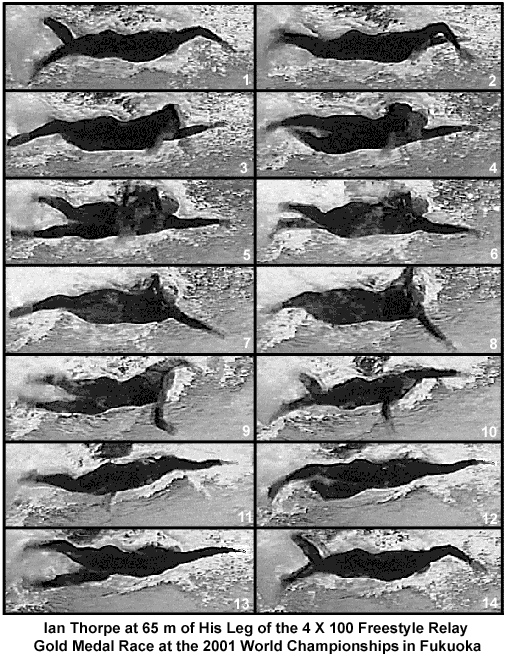HOW CHAMPIONS DO IT
Researched, produced, and prepared by Brent S. Rushall,
Ph.D., R.Psy.

IAN THORPE AT 65 m OF HIS LEG OF THE 4 X 100 m FREESTYLE RELAY AT THE 2001 WORLD CHAMPIONSHIPS IN FUKUOKA
Each frame is .1 seconds apart. Ian Thorpe's time for this leg of the event was 47.87, the second fastest leg of all swimmers in the race (Pieter Van Den Hoogenbond was faster).
This analysis was derived from some very poor video, hence its black and white presentation. It is a continuing determination of changes in Ian Thorpe's stroking over different racing distances. The duration of this stroke is marginally less that 1.4 seconds, which compares to 1.5 seconds for 200 m, 1.6 seconds for 400 m, and 1.8 seconds for 800 m races. With increasing distance, the duration of Ian Thorpe's arm stroke cycle increases.
This stroke analysis includes a moving sequence in real time, a moving sequence where each frame is displayed for .5 of a second, and still frames.
The following image sequence is in real time. It will play through 10 times and then stop. To repeat the sequence, click the browser's "refresh" or "reload" button.

The following image sequence shows each frame for half a second. It will play through 10 times and then stop. To repeat the sequence, click the browser's "refresh" or "reload" button.

At the end of the following narrative, each frame is illustrated in detail in a sequential collage.
Notable Features
Frame #1: The right arm begins its propulsion. The typical "Thorpe stroke" of assuming a high-elbow position well in front of the swimmer is obvious. The left arm approaches entry. The left leg kicks hard and deep to offset the vertical force component produced by the right arm's repositioning and upper arm abduction.
Frame #2: The right arm is propelling "hard". Abduction of the upper arm produces the power for the stroke with the whole arm constituting the propelling surface.
Frame #3: The right leg drops down and "steers" the swimmer straight. This action counteracts the lateral forces produced by the pulling right arm, which is at its widest point. Without a corrective leg action, the swimmer would veer to the left or alternatively, bend at the waist. The turbulence coming off the swimmer's face indicates that the head position could be improved by the swimmer looking directly to the bottom of the pool. As it is, the water having to flow across a relatively upright face causes much turbulent drag across the face profile, which continues down off the chin and along the chest.
Frame #4: The right arm is nearing the end of efficient adduction and beginning to extend at the elbow. Preparatory to exiting, the left leg commences to kick. The upright head position can be seen in this frame and large drag turbulence still emanates from the chin.
Frame #5: The right elbow has exited. The right hand begins to round-out to conserve energy. The left leg kicks to counter-balance the vertical forces created by the recovering arm. The left arm has started to press down and out. The upright face position is again obvious. It is a testimony to this swimmer's great flexibility that such a face position could be sustained and not cause a distortion in postural streamline.
Frame #6: The camera angle distorts the perceived action of the left arm. At this time in the stroke, the left upper arm medially rotates and the elbow flexes. The right leg kicks to counter-balance the vertical forces created by the movements involved in this repositioning action.
Frame #7: The left arm still repositions, but not as effectively as the right arm. The upper arm abducts and the elbow flexes. The poor face position begins to generate considerable drag resistance again.
Frame #8: The entire left arm constitutes the propelling surface powered by upper arm abduction. The recovering right arm is almost "opposite" the left arm. The left leg begins to kick.
Frame #9: The left leg kicks as the right arm approaches entry. The pulling left arm starts to adduct. The body needs to roll quite fast to accommodate the right arm entry and to clear the left hip away for the left arm to recover. The left leg kick assists the body to roll the left side up as well as counter-balance the vertical forces created by the descending right arm.
Frame #10: The head-up position of the swimmer causes a disruption to streamline. The line from the kicked left leg to the top of the head is far from horizontal. Left arm propulsion continues, being near the end of adduction.
Frame #11: The right leg begins to kick to counter-balance the vertical force component of the exiting left arm. The right arm remains stretched forward.
Frame #12: The left arm exits and the right leg completes its kick. The left leg begins to kick to counter-balance the vertical forces created by the right arm repositioning for an effective pull.
Frame #13: The right arm begins to reposition. The right shoulder is extended forward, the upper arm begins to medially rotate, and the elbow flexes. The left leg kicks to counter-balance the vertical force components created by the repositioning.
Frame #14: The position displayed in Frame #1 is duplicated.

Return to Table of Contents for this section.






